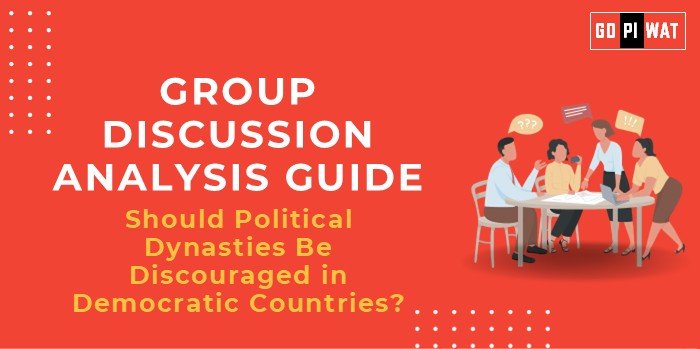📋 GROUP DISCUSSION (GD) ANALYSIS GUIDE
Should Political Dynasties Be Discouraged in Democratic Countries?
🌐 Introduction
Political dynasties, while rooted in cultural traditions, present a dichotomy in democratic values. On one hand, they reflect continuity and voter trust; on the other, they challenge meritocracy and inclusivity, key tenets of democracy.
📊 Quick Facts and Key Statistics
- 🌍 Global Prevalence: Nearly 50% of democratic countries have elected multiple leaders from the same family, with 15% currently led by a descendant of a former leader.
- ⚖️ Meritocracy vs. Nepotism: Dynasties can concentrate power, leading to governance driven by lineage rather than merit.
- 👩🎓 Youth Disengagement: Perceptions of limited opportunities for non-dynastic entrants discourage youth from political engagement.
- 📈 Election Trends: Six out of eleven Southeast Asian nations are governed by political family dynasties, showing a regional trend.
👥 Stakeholders and Their Roles
- 🗳️ Voters: Hold the power to disrupt dynastic dominance through informed choices.
- 🏛️ Political Parties: Often perpetuate dynasties for stability and continuity.
- 🌟 Youth Leaders: Struggle to compete in systems favoring entrenched families.
- 📰 Civil Society and Media: Advocate for merit-based systems and increased transparency.
🏆 Achievements and Challenges
- Achievements:
- 🔗 Continuity: Sustains stable policies across generations.
- 📚 Institutional Knowledge: Provides experienced leadership.
- Challenges:
- 🚫 Undermined Meritocracy: Limits entry of competent outsiders.
- 👎 Disengaged Youth: Reduces young leaders’ participation in governance.
- 📍 Regional Example: Southeast Asia’s dynastic prevalence contrasts with the competitive, merit-driven systems of Western democracies.
- 📖 Case Study: Philippines’ Marcos family—balancing legacy and ongoing criticisms.
✨ Effective Discussion Approaches
- Opening Approaches:
- “Nearly 15% of global democracies are led by descendants of former leaders, highlighting dynasties’ entrenched power.”
- “The dominance of dynasties in six Southeast Asian nations raises critical questions about merit and governance in the region.”
- Counter-Argument Handling:
- Meritocracy rebuttal: “While dynasties ensure stability, robust democracies thrive on competitive, inclusive systems.”
🔍 Strategic Analysis of Strengths and Weaknesses
- Strengths: Legacy leadership, voter familiarity.
- Weaknesses: Limited innovation, nepotism risks.
- Opportunities: Policy reforms to promote meritocracy.
- Threats: Decline in democratic competitiveness and youth engagement.
🛠️ Structured Arguments for Discussion
- 💪 Supporting Stance: “Political dynasties ensure continuity and long-term governance, as seen in Southeast Asia’s stable leadership models.”
- 📉 Opposing Stance: “Dynasties perpetuate nepotism, sidelining merit and weakening democratic foundations.”
- ⚖️ Balanced Perspective: “While dynasties offer continuity, they must coexist with meritocratic mechanisms to safeguard democracy.”
📚 Connecting with B-School Applications
- Real-World Applications:
- Leadership analysis, voter behavior studies, governance challenges in family-run entities.
- Sample Questions:
- “How do political dynasties impact democratic values?”
- “Can dynastic governance coexist with meritocracy?”
- Insights for Students:
- Study leadership evolution and strategize reforms for inclusive governance.


